When you use the D&D Beyond Encounters tool, you'll notice that monster stat blocks have buttons you can click to easily roll for attacks, damage, saving throws, and ability checks. These fancy buttons are powered by something that looks more like eldritch script—or worse, code!
In this tutorial, we'll explain how dice blocks work, how to set them up yourself, and a few useful shortcuts you can use.
- What Is the Encounters Tool?
- What Is a Rollable Dice Block?
- Components of a Rollable Dice Block
- Attack/Spell Blocks
- Damage/Healing
- Recharge
- Generic Roll
- Automatic Rollable Dice Blocks
What Is the Encounters Tool?
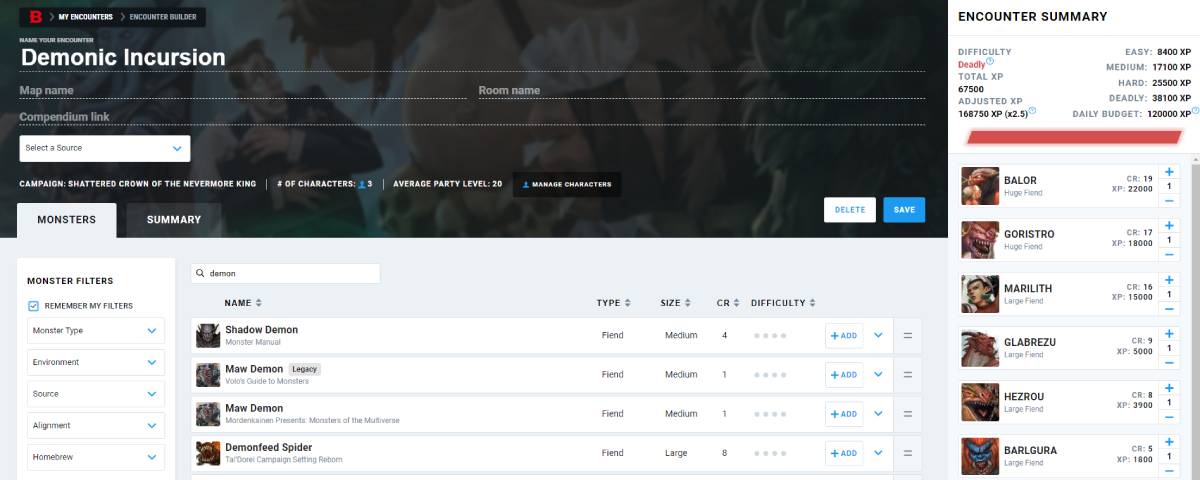
Encounters is two powerful tools in one package available to D&D Beyond users. It combines a combat difficulty calculator and an initiative tracker, allowing you to take an encounter from an idea to a thrilling fight in one place.
The first part of the tool automates the encounter building rules found in the 2014 Dungeon Master's Guide, saving you from having to calculate XP budgets and difficulty thresholds. You can pull in all the monsters you have access to, including homebrew ones.
Once you've designed your perfectly deadly encounter, you can hit "Run" and start rolling those dice.
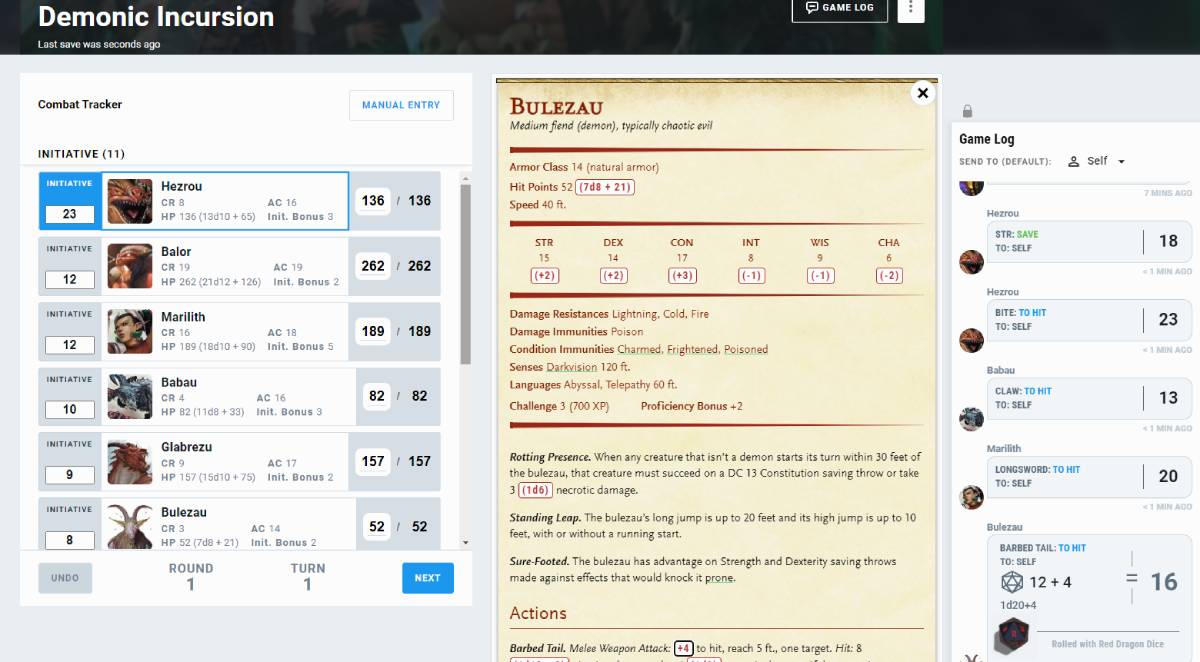
But speaking of homebrew and rolling dice, you may wonder how to add those handy dice buttons. Well, it's all down to rollable dice blocks, the secret behind making your custom monsters roll-ready.
What Is a Rollable Dice Block?
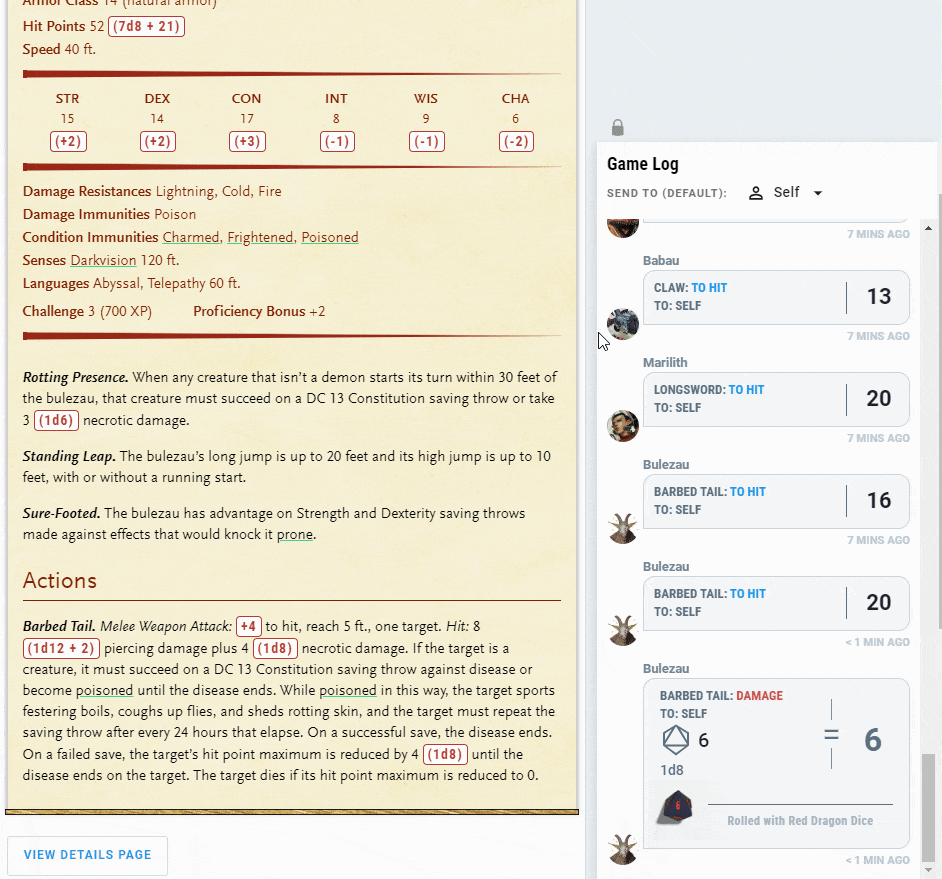
A rollable dice block is a special bit of text that you add to a monster stat block. Outside of the encounter builder and initiative tracker built into Encounters, you won't even know it's there.
But when you load a creature up in either of those tools, the rollable dice block transforms into a clickable button that lets you roll dice directly from the stat block. When you click the button, it not only rolls the associated dice and adds any bonuses, but the result is displayed in the Game Log along with the ability's name, what type of roll it is, and any associated damage types.
There are four types of rollable dice blocks you can find in a monster stat block:
- Attack/Spell
- Damage/Healing
- Recharge
- Generic Roll
This tutorial will cover each rollable dice block type and how you set it up. But first, let's cover some of the fundamental elements of a rollable dice block.
Components of a Rollable Dice Block
All rollable dice blocks are wrapped in rollable tags, which means you need [rollable] at the start and at the end [/rollable]. This tells the site that what you're writing needs to be handled in a special way. Whatever you write immediately after the [rollable] tag, followed by a semicolon, will be displayed on your monster's stat block. For example, writing:
[rollable]+4;
Will be displayed as "+4" on the stat block as a button when using the Encounters tool. Outside of the Encounters tool, this will appear as plain text.

The next bit is the fancy part: the dice notation. After the semicolon of your button text, you put a pair of curly brackets containing "diceNotation:"
[rollable]+4;{“diceNotation”:}
After the colon is where the magic happens. You tell the site what dice to roll, what modifiers to apply, and what information to display. A comma will separate each element and consist of an element category in quotation marks, a colon, and then the type.
These are the following dice element categories:
- "diceNotation:" The actual dice and modifiers that will be rolled when you click the button.
- "rollType:" What type of dice roll is being made, such as a spell, damage, recharge, or general roll.
- "rollAction:" The name of the ability being rolled, such as the name of the attack or damage.
- "rollDamageType:" For blocks that have damage, this will list the damage type for the game log.
Attack/Spell Blocks
Attack and Spell Attack blocks are used whenever you want a clickable attack roll. When writing an attack or spell attack dice block, your dice notation will always be 1d20 plus a number, which will be the to-hit bonus.
Let's start making a weapon attack for our monster, the pancake elemental:
[rollable]+4;{"diceNotation":"1d20+4",
Note the parts in bold. They should be the same. Also, don't forget to use colons and commas in the right places to tell the site where elements begin and end.
Next, we want to tell the site what type of roll this is. For attack rolls, it's "to hit" and for spells, it's "spell". Let's take the above example and make it an attack roll:
[rollable]+4;{"diceNotation": "1d20+4", "rollType": "to hit",
Finally, we want to set the name of this dice block, which, in this case, is the attack's name. Let's say it's for an attack called Batter Flip; we'll want to use "rollAction" followed by the name:
[rollable]+4;{"diceNotation": "1d20+4", "rollType": "to hit", "rollAction": "Batter Flip"}
That's almost everything. The last thing we need to do is add the closing [/rollable] tag like this:
[rollable]+4;{"diceNotation": "1d20+4", "rollType": "to hit", "rollAction": "Batter Flip"}[/rollable]
Unlike all the other elements, we don't need a comma after the rollAction because we're ending the dice block. It's important to check that all your colons and commas are in the right place because dice blocks are a stickler for precision.
If you wanted to write a spell attack block, it'd look pretty much the same, except the rollType would be "spell" instead:
[rollable]+3;{"diceNotation": "1d20+3", "rollType": "spell", "rollAction": "Big Spell"}[/rollable]
Damage/Healing
You've got your to-hit roll sorted, so now you need damage rolls. These are very similar, with only one additional element, "rollDamageType." We'll follow the same steps as above, first defining the opening rollable tag and the button. We want Batter Flip to deal 2d8+2 fire damage, so that's what we'll put after the rollable tag:
[rollable](2d8 + 2);
Note that the dice block is written inside a pair of parentheses. When writing out damage or healing in D&D, you write the average first, then the dice roll in parentheses. We only want the dice roll to be a button, so that's the part we put within the rollable tag.
Next up, we want to write out the diceNotation, which follows the same format as for to-hit rolls. Just make sure it matches what you wrote for the button:
[rollable](2d8 + 2);{"diceNotation":"2d8+2",
Now we add the rollType, which in this case is damage, and the rollAction name to display:
[rollable](2d8 + 2);{"diceNotation": "2d8+2", "rollType": "damage", "rollAction": "Batter Flip",
This is where we add the new element unique to damage rolls, rollDamageType. This defines what type of damage the roll is, which will be displayed in the Game Log. In this case, we're going with fire damage:
[rollable](2d8 + 2);{"diceNotation": "2d8+2", "rollType": "damage", "rollAction": "Batter Flip", "rollDamageType": "fire"
That is our almost complete damage dice block. We just need to close the rollable tag by adding the closing curly brace and [/rollable]:
[rollable](2d8 + 2);{"diceNotation": "2d8+2", "rollType": "damage", "rollAction": "Batter Flip", "rollDamageType": "fire"}[/rollable]
If you wanted instead to make a dice block for a healing roll, you change the rollType from "damage" to "heal" and remove the rollDamageType, like this:
[rollable](2d4);{"diceNotation": "2d4", "rollType": "heal", "rollAction": "Smol Heal"}[/rollable]
Recharge
Some monsters, such as the legendary ancient red dragon, feature abilities that recharge at the start of their turn on a roll of a d6. These blocks are even simpler than the previous examples. The first element is the button immediately after the opening rollable tag:
[rollable](Recharge 6);
The recharge value may vary, from 4-6 to just 6, but this doesn't actually change the dice block itself. Once you've got your button text defined, the recharge dice block follows a familiar structure:
[rollable](Recharge 6);{"diceNotation": "1d6", "rollType": "recharge", "rollAction": "Breath Weapon"}[/rollable]
The important elements are highlighted in bold; the diceNotation is always 1d6, and the rollType is "recharge."
Generic Roll
Finally, here is the structure for just making a generic, multipurpose dice roll block, such as for determining a random effect on a table:
[rollable]10d20 + 23;{"diceNotation": "10d20 + 23", "rollType": "roll", "rollAction": "Big Roll"}[/rollable]
You'll see that it's very simple compared to the previous examples, with the only unique element being that its rollType is "roll", which is fairly self-explanatory.
Automatic Rollable Dice Blocks
If all this seems a little too much like wizardry to you, don't worry, as the D&D Beyond homebrew tools have an unseen servant waiting to lend you a hand. If you go into the homebrew tools and look at the toolbar in any text input field, you'll see a small calculator-looking icon at the far end of the toolbar; this is the automatic rollable dice block tool.

If you highlight an attack action, recharge ability, or other similar feature where you'd like to add a dice block and click that button, a dialogue box will appear.
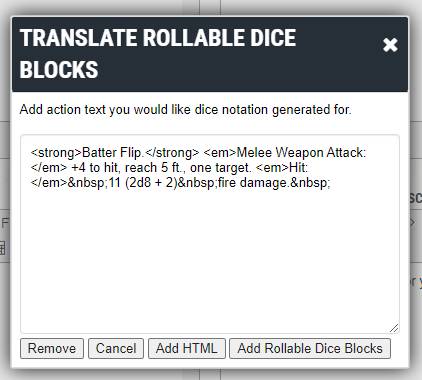
Once that dialogue appears, click "Add Rollable Dice Blocks," and you'll see the text converted automatically to a dice block!
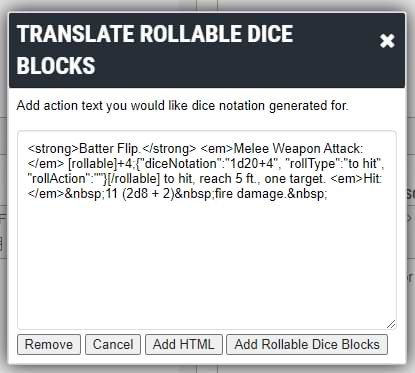
It's important to keep in mind that this tool will do its best to correctly format the dice block for you, but it may not properly register every element every time. As such, it's useful to understand how the dice blocks work so you can fix an error yourself.
Get Rolling!
With D&D Beyond's suite of tools, prepping D&D has never been easier. Whether you're homebrewing monsters using the creation tools, planning combat using Encounters, or running the game through Maps, we're here to take work off your plate so you can focus on the fun!
Davyd is a moderator for D&D Beyond. A Dungeon Master of over fifteen years, he enjoys Marvel movies, writing, and of course running D&D for his friends and family, including his daughter Willow (well, one day). The three of them live with their two cats Asker and Khatleesi in south of England.








-
View User Profile
-
Send Message
Posted Jan 25, 2024Homebrewing Monsters and Rollable Buttons are great, but it would be much, MUCH better if we could add Check Boxes that make keeping track of "X/Day" abilities and spells super easy and convenient!
Korvax the Benevolent can cast 4x 1st Level Spells, 3x 2nd and 3rd Level Spells, and 2x 4th Level Spells? We're now in the fourth round of combat, did I have Korvax use any of his 4th Level Spells yet, or was that Garlux the Malevolent? What happened in the first round again? Damn it, where is that scrap of paper I was marking things on?
If only DnDBeyond had a way for me to tick off Monster Spell Slots as I use them!
https://www.dndbeyond.com/forums/d-d-beyond-general/d-d-beyond-feedback/30499-request-and-vote-for-new-features-for-ddb?comment=2411
-
View User Profile
-
Send Message
Posted Jan 26, 2024No lie. Our party has 2 steeds, 1 animal companion and 3 familiars. On top of that we often use Animate Objects and have a few favorite Polymorph forms.
-
View User Profile
-
Send Message
Posted Jan 26, 2024No lie. Our party has 2 steeds, 1 animal companion and 3 familiars. On top of that we often use Animate Objects and have a few favorite Polymorph forms.
-----
Yeah, seriously. I have to go to other apps to make up for this and end up handing my device around so others can roll for their summons or random stat block. It's been years and I still hope that it'll just show up as the rest of the sheet. Even if I could use homebrew to set it up for everyone, it would be so cool... 😔
-
View User Profile
-
Send Message
Posted Jan 26, 2024You know, I tried this a while back on some homebrew stuff...
It didn't work at all lol.
-
View User Profile
-
Send Message
Posted Jan 26, 2024As the person playing the lore bard with ritual caster, I wind up creating custom weapons with hard-coded attack & damage bonuses, set to zero weight. It lets me roll "Pegasus kick","Gryphon claw", "Tiny Animated Object" and "Bat perception"
But when I polymorph the fighter into a giant ape so they can grapple a dragon, they have to struggle with one-off die rolls.
-
View User Profile
-
Send Message
Posted Jan 26, 2024It's great that they're finally talking about this, it took me a while to figure it out on my own. However, we should not settle just for this. I hope that DND Beyond is planning to make this MUCH easier in the future. There should be options in the homebrew settings to add attacks, spells, actions, etc with simple numeric inputs. In fact, they already have this system in place with custom spells and magic items. You don't have to do any weird pseudo coding text, you simply select what type of trait or spell the item has, and any numeric values associated with it. It should be taken a step further where you have a simple table of inputs where you can type in the exact name, AB, damage, and properties of an attack and have it automatically populate in the completed homebrew stat block with the correct verbage. This is even more convenient for spells, and could include a way to track a creature's spell slots digitally, and select from a list of spells they've prepared in advance. Currently, despite making countless homebrew creatures, fixing the attacks to have this notation takes way too long, not because I don't know how, but because it's simply laborious, and not how I'd like to spend my time as a DM. I'm not sure how many software developers and programmer they have on staff, but this shouldn't be too complicated an addition unless the coding they have on the back end is a total mess.
-
View User Profile
-
Send Message
Posted Jan 26, 2024100% agree. Why are we being asked to do the notation that should be automated on the back end anyway XD. We should be able to put "4" in a box for "rollable attack bonus" and have it spit it out in the stat block autmatically.
-
View User Profile
-
Send Message
Posted Jan 26, 2024100% agree. Why are we being asked to do the notation that should be automated on the back end anyway XD. We should be able to put "4" in a box for "rollable attack bonus" and have it spit it out in the stat block automatically.
-
View User Profile
-
Send Message
Posted Jan 26, 2024It's wild that we have to use a non-integrated system to do something that should be automated in house anyway
-
View User Profile
-
Send Message
Posted Jan 26, 2024Honestly it'd be even better if the system wasn't so convoluted and laborious. Then they wouldn't need articles like this XD
-
View User Profile
-
Send Message
Posted Jan 26, 2024Is there a version of this for spells in homebrew magic items?
-
View User Profile
-
Send Message
Posted Jan 26, 2024To keep credit to MidnightOil21, this user made a great generator that does this. I agree though, this rollable tags function is a lot more complicated than it should be, until it's coded more efficiently, here's the rolla le tag thread to oil's generator:
https://www.dndbeyond.com/forums/dungeons-dragons-discussion/homebrew-house-rules/106856-adding-rollable-tags-to-your-homebrew-monsters-for?comment=130
-
View User Profile
-
Send Message
Posted Jan 26, 2024Thanks to Desmond_Oakenbrand for the keep highest / keep lowest notation. I love it!
-
View User Profile
-
Send Message
Posted Jan 26, 2024Thank you! I’ve been copying and modifying blocks for a while and this is incredibly helpful to understand the how’s and why. Bookmarking this one for sure!
-
View User Profile
-
Send Message
Posted Jan 26, 2024I did. You missed a key detail in my comment. Instead of burying it in that ugly mess build it into an actual user-friendly interface. Just drop in the numbers in the right box and it creates a field in the finished product. You are still dealing with the text mess with the translation tool which was noted not always to work. There is already a similar function in the character sheets where you can add things like custom actions. It is a pretty straightforward interface of quick simple menu options you just put in the info you want and it creates the rollable result on the character sheet under actions. There is none of that tangled mess involved at all.
-
View User Profile
-
Send Message
Posted Jan 26, 2024Oh, I’d much rather just type it out, hit a couple of buttons and it’s done. Dealing with all those fields and dropdowns is a much bigger pain in the patooty.
-
View User Profile
-
Send Message
Posted Jan 26, 2024I used to delete the code because it looked ugly, but then I wanted to use the encounter builder, so I realized what it was. I just wish this came out sooner.
ALSO WATCH OUT FOR GRAMMAR ERRORS THEY RUIN CODE.
-
View User Profile
-
Send Message
Posted Jan 27, 2024On the subject of adding rollable dice.
The Artificer's Steel Defender lacks rollable dice.
-
View User Profile
-
Send Message
Posted Jan 27, 2024Super the number of times I've dug through the forums FAQ's for the syntax...
Thanks a lot @Davyd
-
View User Profile
-
Send Message
Posted Jan 27, 2024Bookmarking this article for later reference.